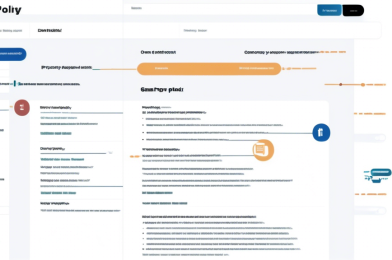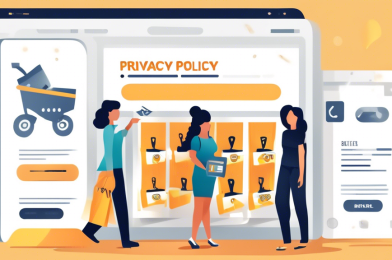Discover Online Privacy: Essential Tips for Safeguarding Your Digital Life
In our increasingly interconnected world, understanding and protecting your online privacy is more crucial than ever. As we navigate through the digital landscape, we leave traces of personal information that can be exploited by malicious entities. Whether it’s cybercriminals, data brokers, or intrusive surveillance systems, the threats to our digital lives are real and growing.
Why does online privacy matter so much in today’s digital age? Every interaction, from social media posts to online banking transactions, can potentially expose sensitive data if not properly secured. The consequences of data breaches and unauthorized access can be severe, ranging from identity theft to significant financial loss.
To help you navigate these challenges, this article will provide essential tips for protecting your online privacy. By implementing these strategies, you can significantly reduce the risks and safeguard your digital life against common threats.
Why Online Privacy Matters: Understanding the Basics
The importance of online privacy cannot be overstated. With the rise of cyberattacks and increasing instances of data surveillance, the need to secure your personal information has never been greater. Statistics reveal a troubling picture: data breaches are more frequent, and their impacts are more destructive than ever before.
Why Online Privacy Matters: Understanding the Basics
Importance of Online Privacy
In today’s increasingly digital world, understanding the importance of online privacy is crucial. Your online presence involves sharing a significant amount of personal information, ranging from your social media activity to sensitive financial details. Safeguarding this data is essential to protect your identity, maintain your reputation, and ensure peace of mind. When you discover online privacy practices, you take the first step towards securing your digital life against a myriad of potential risks.
Online privacy matters not just to individuals but also to businesses. A breach of privacy can lead to financial losses, legal consequences, and a tarnished reputation. For individuals, maintaining online privacy protects against identity theft, data exploitation, and other malicious activities. For businesses, it’s critical in preserving customer trust and complying with data protection regulations like the GDPR (General Data Protection Regulation) and CCPA (California Consumer Privacy Act).
Common Threats to Your Digital Life
Your journey to discover online privacy should start with an awareness of the common threats that could compromise your digital security. These threats include:
- Phishing Attacks: Malicious emails or messages designed to trick you into revealing personal information such as passwords and credit card numbers.
- Malware: Software designed to damage, disrupt, or gain unauthorized access to your computer systems. Malware can come in various forms, including viruses, ransomware, and spyware.
- Data Breaches: Incidents where hackers gain access to a company’s data storage, often leading to the exposure of personal information of millions of users.
- Social Engineering: Techniques used by cybercriminals to manipulate individuals into divulging confidential information.
- Online Surveillance: The monitoring of your online activities by governments, corporations, or hackers for various purposes, sometimes infringing on your privacy rights.
Understanding these threats is a fundamental step in your journey to discover online privacy and take proactive measures to safeguard your digital footprint.
Statistics on Data Breaches and Online Surveillance
To grasp the gravity of online privacy issues, consider the alarming statistics surrounding data breaches and online surveillance. The number of data breaches has been on the rise, affecting millions of individuals globally. For instance:
- In 2021, there were over 1,000 data breaches reported in the United States alone, exposing more than 155 million records. (Source: Identity Theft Resource Center)
- Between 2020 and 2021, there was a 56% increase in compromised users and a 40% rise in compromised networks globally. (Source: IBM Security)
- According to the Verizon Data Breach Investigations Report, 85% of breaches involved a human element, showcasing the importance of awareness and active participation in privacy practices.
Online surveillance isn’t just a theoretical concern. Governments worldwide have implemented various surveillance measures, sometimes overstepping boundaries and infringing on individual privacy rights. The revelations by Edward Snowden in 2013 brought to light the extensive surveillance conducted by the NSA, sparking a global debate on privacy and security balance.
It is clear that understanding and addressing online privacy issues is no longer optional; it is a necessary measure in our digital age. When you choose to discover online privacy, you empower yourself to protect your digital identity against these pervasive threats.
Essential Tips for Protecting Your Online Privacy
Strengthening Passwords and Using Two-Factor Authentication
One of the most fundamental steps to discover online privacy is ensuring you have strong, unique passwords for all your accounts. Avoid using easily guessable information such as birthdays or common words. Instead, create complex passwords that include a mix of letters, numbers, and special characters.
Additionally, consider using a password manager to keep track of your passwords. These tools can generate strong, random passwords and store them in an encrypted database, making it easier for you to maintain good password hygiene without the hassle of remembering each one.
Implementing Two-Factor Authentication (2FA) adds an extra layer of security to your accounts. Even if someone gains access to your password, they will still need the second authentication factor, which is usually a code sent to your phone or an authentication app, to log in. This significantly reduces the risk of unauthorized access, providing an essential safeguard for your online privacy.
Using Secure Browsers and Privacy-Focused Search Engines
Your choice of browser and search engine can have a significant impact on your online privacy. Standard web browsers often track your activity and share it with advertisers, so it is advisable to opt for privacy-focused browsers like Mozilla Firefox or Brave. These browsers offer better security features, such as blocking trackers and ads, which can prevent unauthorized tracking of your online behavior.
Equally important is using a privacy-focused search engine. Popular search engines like Google collect enormous amounts of data on their users. Search engines like DuckDuckGo and StartPage, on the other hand, do not track or store your search history, making them better alternatives for maintaining your online privacy.
By switching to secure browsers and privacy-focused search engines, you can significantly reduce the amount of personal data that is collected and shared online.
The Role of VPNs and Encryption in Safeguarding Your Data
Virtual Private Networks (VPNs) and encryption play crucial roles in protecting your online privacy. A VPN creates a secure, encrypted connection between your device and the internet. This allows you to mask your IP address and encrypt your internet traffic, making it difficult for hackers and third parties to intercept your data.
Selecting a reliable VPN service is essential. Look for providers that offer strong encryption protocols, a no-logs policy, and have a good reputation for protecting user privacy. For instance, services like NordVPN, ExpressVPN, and ProtonVPN are known for their robust security features and privacy protection practices.
In addition to VPNs, using encryption tools for your communications can further safeguard your data. Software like Signal or ProtonMail provides end-to-end encryption for your messages and emails, ensuring that only you and the intended recipient can access the content. This is particularly important for sensitive information that you do not want to be intercepted by malicious actors or governmental surveillance.
By integrating VPNs and encryption into your online routine, you can create a more secure digital environment, enhancing your overall online privacy.
Maintaining Continuous Vigilance: Best Practices and Tools
Online privacy is an ongoing commitment rather than a one-time setup. To truly discover online privacy, you must adopt a mindset of continuous vigilance. This section will explore critical best practices and introduce essential tools to help you monitor and manage your online presence effectively.
Regularly Updating Software and Devices
One of the simplest yet most crucial steps in maintaining your online privacy is keeping your software and devices up to date. Cybercriminals constantly look for vulnerabilities in software, which can serve as gateways to infiltrate your systems. Software updates often include patches for these vulnerabilities, thereby enhancing your security.
Ensure that your operating systems, browsers, and applications are set to update automatically. This proactive approach minimizes the risk of your personal information being compromised. Additionally, regularly update the firmware on your smart devices, as these can also be targeted by cyber threats.
Recognizing and Avoiding Phishing Scams
Phishing scams are surreptitious attempts to acquire sensitive information such as usernames, passwords, and credit card details by masquerading as a trustworthy entity in digital communications. Knowing how to identify these scams is a crucial part of your journey to discover online privacy.
Be skeptical of unsolicited emails, messages, or phone calls that ask for personal information. Look for signs such as:
- Suspicious Sender Addresses: Check the email address or phone number of the sender. Often, phishing attempts come from addresses that are similar, but not identical, to legitimate sources.
- Urgent or Threatening Language: Be wary of messages that create a sense of urgency or impending doom to elicit an immediate response.
- Poor Grammar and Spelling: Many phishing messages are poorly written, with numerous grammatical errors and awkward phrasing.
If in doubt, contact the purported source directly using a verified contact method to confirm the authenticity of the communication. By honing your ability to recognize and avoid phishing scams, you significantly bolster your online privacy.
Essential Tools for Monitoring and Managing Your Online Presence
To proactively manage your digital footprint and enhance online privacy, utilize essential tools designed for monitoring and controlling your online presence. These tools provide a layer of defense and transparency, offering insights into how your data is being used and alerting you to potential privacy issues.
Privacy Management Tools
- Ghostery: Ghostery is a browser extension that blocks trackers and advertisements, enhancing your browsing privacy by preventing companies from collecting your data.
- Privacy Badger: Created by the Electronic Frontier Foundation, Privacy Badger automatically blocks invisible trackers and helps keep your browsing activities private.
- DuckDuckGo Privacy Essentials: This all-in-one privacy solution offers private search, tracker blocking, and encryption, ensuring a safer browsing experience.
Data Breach Monitoring
- Have I Been Pwned: A free service that allows you to check if your email address or phone number has been compromised in a data breach. By knowing which data breaches have affected you, you can take appropriate measures to secure your accounts.
- Mozilla Firefox Monitor: Powered by Have I Been Pwned, Firefox Monitor provides alerts if your information appears in a data breach and offers guidance on securing compromised accounts.
Virtual Private Networks (VPNs)
VPNs are indispensable tools for maintaining online privacy. They encrypt your internet connection, making it difficult for third parties to track your online activities. When choosing a VPN, consider the following factors:
- No-log Policies: Ensure the VPN provider does not keep logs of your activity.
- Strong Encryption: Look for VPNs that use advanced encryption standards for maximum security.
- Reputable Providers: Choose well-known and trusted providers with a proven track record of maintaining user privacy.
Password Management Tools
Using a password manager is an excellent way to create and store strong, unique passwords for all your accounts, significantly reducing the risk of credential theft. Consider using one of the following password managers:
- 1Password: This tool offers robust security features, including two-factor authentication and a password generator.
- LastPass: Popular for its user-friendly interface, LastPass also provides secure password storage and automated password changing.
- Bitwarden: An open-source password manager that offers strong security features and cross-platform compatibility.
Mobile Privacy Tools
Your mobile devices are just as vulnerable as your desktop and laptop computers. Utilize mobile privacy tools to protect your data on the go:
- Signal: An encrypted messaging app that ensures your communications remain private.
- App Permissions Manager: Use this feature on your device to control app permissions and prevent unnecessary data collection.
- Mobile VPN: Just like on your computer, using a VPN on your mobile device can protect your browsing data from prying eyes.
Maintaining continuous vigilance requires a combination of best practices and essential tools. By regularly updating your software, recognizing phishing scams, and leveraging privacy management tools, you can discover online privacy and safeguard your digital life effectively. Stay proactive and informed to ensure your online presence remains secure and private.
Conclusion: Taking Charge of Your Digital Life
In today’s interconnected world, safeguarding your online privacy is more critical than ever. As we’ve discussed, understanding the basics of online privacy, recognizing the common threats, and acknowledging the escalating statistics on data breaches and surveillance form the foundation of protecting yourself in the digital realm.
By integrating essential tips such as strengthening passwords, utilizing two-factor authentication, and leveraging secure browsers and privacy-focused search engines, you can create a robust first line of defense. Further, the implementation of VPNs and encryption serves as an additional layer of security, ensuring that your data remains protected from prying eyes.
Maintaining continuous vigilance through regular updates, recognizing phishing scams, and utilizing tools to monitor and manage your online presence is vital. These practices not only help in preserving your privacy but also contribute to a safer, more secure digital environment.
Empower Yourself with Knowledge
The journey to discover online privacy doesn’t end here. As technology evolves, so do the methods used by malicious actors. Stay informed, remain proactive, and continue learning about new tools and strategies to keep your digital life secure. By taking these steps, you are not only protecting your personal information but also contributing to a broader culture of privacy and security in the online community.









